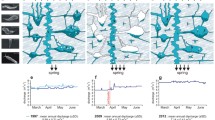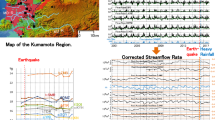Abstract
This paper discusses the influence of earthquakes on large water ecosystems, with particular emphasis on Lake Sevan, Armenia. Earthquakes impact on large lacustrine ecosystems in seismically active areas in a number of ways, including chemistry and lake dynamics. Conclusions are drawn from a large database that includes biological, hydrological, geochemical and seismic information. Strong earthquakes change the water chemistry and pH of the lake and consequently the chemical and biological processes that take place in the lake bed sediments. Analysis of historical earthquakes shows their influence on the organic carbon in the sediments, the changes of the lake dynamics and variations in bacteria, phytoplankton and zooplankton at the base of the food chain.
Similar content being viewed by others
References
Afanasev, G. D., 1933. Sediment of Lake Sevan. The basin of Lake Sevan (Geokcha). Volume 3, part 2. Leningrad: 53–154 (in Russian).
Arnoldi, L. B., 1929. Materials for study of the productivity of Lake Sevan. Volume 2, Part 1. Yerevan: 96 pp (in Russian).
Balassanian, S. (ed.), 1996 The Strong Motion Network of the Spitak Area. Bulletin of Strong Motion, May 1991–November 1996: 67 pp. (in Russian).
Barsukov, V. L., A. A. Beliaev, V. A. Bakalin, V. A. Igumnov, T. L. Ibragimova, V. S. Serebrennikov & A. N. Sultankhojaev, 1992. Geochemical methods for earthquake prediction. Nauka, Moscow: 213 pp. (in Russian).
Crouse, C. B. & M. Eeri, 1990 Ground-motion attenuation equations for earthquakes on the Cascadia subduction zone. Earthquake spectra 7(2): 201–236.
Davidov, V. K., 1938. Water Balance of Lake Sevan. Material for the research of Lake Sevan and its basin. Part. 6 [Leningrad] (in Russian).
Feodotov, S. A., G. V. Chernysheva & L. S. Shumilina, 1993. Seismicity of Kamchatka and the Commander Islands, based on detailed observations during 1962–1990. J. Earthquake Prediction Res. 2 (1): 49–69.
Filatov, N. N., 1983. Dynamics of Lakes. Leningrad: 166 pp. (in Russian).
Gabrielian, H., 1996. Water erosion in Lake Sevan Basin. In Lake Sevan: Problems and Strategies of action. Proceeding of the International Conference (Sevan, Armenia, 13–16th October 1996): 111–112.
Gambarian, M. E., 1962. Microbiological sulphur processing in Lake Sevan. Materials of Sevan Hydro biological station 16: 5–14 (in Russian).
Gambarian, M. E., 1968. Microbiological research of the Lake Sevan. Yerevan: 166 pp. (in Russian). 130
Gulakyan, S., V. Igumnov & Z. Stepanian, 1998. Variations of He related to strong Earthquakes. The second international conference on earthquake hazard and seismic risk reduction: 167 pp.
Hakobyan, M. A. & Y. L. Djomin, 1982. Numerical modeling currents of the Lake Sevan. Meteorol. Hydrol. 8: 68–74 (in Russian).
Hovhannissian, R., 1996. Evolution of eutrofication processes of Lake Sevan and how to control them. In Lake Sevan: Problems and Strategies of action. Proceeding of the International Conference (Sevan, Armenia, 13–16th October 1996): 81–85.
Hovhannissian, R. O., 1994. Lake Sevan Yesterday, Today... Yerevan: 478 pp (in Russian, resumé English).
Igumnov, V. & A. Kazarian, 1995. The geochemical precursors to earthquakes and the relaxation of geochemical parameters. Proceedings of the Scientific Colloquium “Migration of fluids in the subsoil and seismic events: compared experiences”. Venice, 12–13, July 1993, Italy: 148–151 (in Russian).
Karapetyan, B. K. & N. K. Karapetyan, 1981. Prerequisites for earthquake prediction and construction of aseismic buildings in SSR Armenia. Yerevan, Armenia (in Russian).
Legovich, N. A., 1979. ‘Blooms’ in the water of Lake Sevan (Observations 1964–1972). Materials of Sevan Hydrobiological station 17: 51–74 (in Russian).
Li Xuanhu, 1992. Application of the gas geochemistry method in earthquake prediction research. J. Earthquake Prediction Res. 1(1): 223–234.
Ljatti, S. J., 1932. Soils of Lake Sevan – Materials for researching Lake Sevan and its Basin. Volume 2., part 4. Yerevan. (in Russian).
Satian, M. A. & G. V. Chilingaryan (eds), 1994. Geology of Sevan. Academy of Science of the Republic of Armenia, Yerevan: 181 pp. (in Russian).
Simonyan, A. A., 1991. Zooplankton of the Lake Sevan. Yerevan: 298 pp. (in Russian).
Tifenbakh, O. I., 1962. Quantity of bacteria in the water and sediment of the Lake Seven. Materials of Sevan Hydrobiological Station 16: 5–14 (in Russian).
Author information
Authors and Affiliations
Rights and permissions
About this article
Cite this article
Gulakyan, S.Z., Wilkinson, I.P. The influence of earthquakes on large lacustrine ecosystems, with particular emphasis on Lake Sevan, Armenia. Hydrobiologia 472, 123–130 (2002). https://doi.org/10.1023/A:1016398420530
Issue Date:
DOI: https://doi.org/10.1023/A:1016398420530




